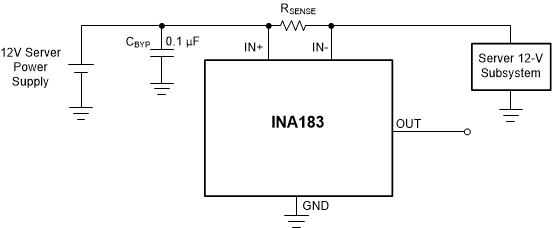SBOSA08 February 2021 INA183
PRODUCTION DATA
- 1 Features
- 2 Applications
- 3 Description
- 4 Revision History
- 5 Device Comparison
- 6 Pin Configuration and Functions
- 7 Specifications
- 8 Detailed Description
- 9 Application and Implementation
- 10Power Supply Recommendations
- 11Layout
- 12Device and Documentation Support
- 13Mechanical, Packaging, and Orderable Information
Package Options
Mechanical Data (Package|Pins)
- DBV|5
Thermal pad, mechanical data (Package|Pins)
Orderable Information
9.2 Typical Application
Figure 9-1 shows the basic connections for the INA183. The input pins, IN+ and IN–, must be connected as close as possible to the shunt resistor to minimize any resistance in series with the shunt resistor.
 Figure 9-1 Typical
Server Application
Figure 9-1 Typical
Server ApplicationA power-supply bypass capacitor is required on the IN+ pin. Applications with noisy or high-impedance power supplies may require additional decoupling capacitors to reject power-supply noise. Connect bypass capacitors close to the device pins.
In server applications, the INA183 typically monitors the current on the 12-V bus that is distributed to various server sub-systems like memory, storage, or CPU power. The monitored current can be used by the server for fault detection or sub-system power optimization.